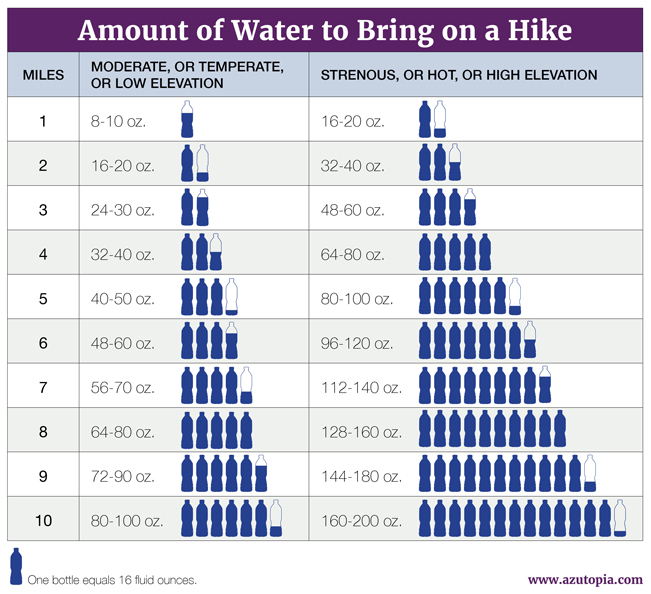Embarking on a hiking adventure is an exhilarating experience, connecting you with nature and challenging your physical limits. However, a crucial aspect often overlooked is proper hydration. Knowing how much water per day when hiking is essential for maintaining energy levels, preventing dehydration, and ensuring a safe and enjoyable trek. Dehydration can lead to fatigue, headaches, and even more serious health complications, so planning your water intake is just as important as planning your route. Therefore, understanding how much water per day when hiking you need is paramount for a successful and healthy hiking experience.
Factors Influencing Water Needs on the Trail
Determining the precise amount of water you need while hiking isn’t a one-size-fits-all answer. Several factors play a significant role in influencing your individual hydration requirements:
- Intensity of the Hike: A strenuous uphill climb will require more water than a leisurely stroll on a flat trail.
- Weather Conditions: Hot and humid weather increases sweat rate and thus, water loss. Conversely, cooler temperatures might decrease your perceived thirst, but you still need to hydrate.
- Individual Physiology: Body weight, metabolism, and sweat rate vary from person to person.
- Duration of the Hike: Longer hikes obviously necessitate more water.
- Altitude: Higher altitudes can lead to increased respiration and fluid loss.
Estimating Your Water Needs
While individual needs vary, a general guideline is to aim for approximately 0;5 liters (16 ounces) of water per hour of moderate hiking. This is a good starting point, but you should adjust this based on the factors mentioned above. For strenuous hikes in hot weather, you might need to double that amount. Consider using a hydration pack or carrying multiple water bottles to ensure you have enough supply. Pre-hydrating before your hike and rehydrating after are also crucial steps.
Practical Tips for Staying Hydrated
- Pre-Hydrate: Drink plenty of water in the hours leading up to your hike.
- Sip Regularly: Don’t wait until you feel thirsty to drink. Take small, frequent sips throughout your hike.
- Electrolyte Replacement: Consider adding electrolyte tablets or powders to your water to replenish lost minerals.
- Monitor Your Urine: Light-colored urine is a good indicator of adequate hydration.
- Plan Your Water Sources: If you’re relying on natural water sources, ensure they are reliable and treat the water properly before drinking.
FAQ: Hiking Hydration
Here are some frequently asked questions about staying hydrated while hiking:
- Q: Can I drink water from streams and lakes?
A: While natural water sources can be tempting, they often contain harmful bacteria and parasites. Always treat water from these sources using a filter, purification tablets, or by boiling it. - Q: What are the symptoms of dehydration?
A: Symptoms include thirst, headache, fatigue, dizziness, dark urine, and muscle cramps. - Q: How can I carry enough water for a long hike?
A: Use a hydration pack or carry multiple water bottles. Consider using a water filter or purification tablets if you plan to replenish from natural sources. - Q: Are sports drinks better than water for hiking?
A: Sports drinks can be helpful for longer, more intense hikes as they provide electrolytes and carbohydrates. However, water is usually sufficient for shorter, less strenuous hikes.
Ultimately, understanding your body and the specific demands of your hike is key to determining the right amount of water you need. Remember to listen to your body, plan ahead, and prioritize hydration for a safe and enjoyable hiking experience. Knowing how much water per day when hiking is not just a suggestion; it’s a necessity for a successful and healthy adventure.
Recognizing and Addressing Dehydration
Dehydration can creep up on you quickly while hiking, especially in challenging conditions. Being able to recognize the early signs is crucial for preventing more serious complications. Pay attention to your body and be proactive in addressing any symptoms. Ignoring the warning signs can lead to heat exhaustion or even heatstroke, which are medical emergencies.
Early Warning Signs of Dehydration:
- Increased thirst
- Dry mouth and throat
- Headache
- Fatigue and weakness
- Dizziness or lightheadedness
- Dark yellow urine
- Decreased urine output
Addressing Dehydration on the Trail:
- Stop and Rest: Find a shady spot to rest and cool down.
- Drink Water: Sip water slowly and steadily. Avoid gulping it down, as this can cause stomach cramps.
- Electrolyte Replacement: If you have electrolyte tablets or a sports drink, consume them to replenish lost minerals.
- Cool Down: If possible, wet a cloth or bandana and apply it to your forehead or neck.
- Seek Help: If symptoms worsen or do not improve after resting and hydrating, seek medical assistance.
Comparative Table: Hydration Strategies for Different Hike Types
| Hike Type | Duration | Intensity | Recommended Water Intake (per hour) | Electrolyte Considerations |
|---|---|---|---|---|
| Easy Day Hike | 2-4 hours | Low | 0.5 liters | Not usually necessary |
| Moderate Day Hike | 4-6 hours | Moderate | 0.75 liters | Consider electrolyte tablets |
| Strenuous Day Hike | 6-8+ hours | High | 1 liter or more | Electrolyte tablets or sports drink recommended |
| Multi-Day Backpacking Trip | Multiple days | Variable | 1 liter or more (adjust based on conditions) | Electrolyte tablets or sports drink essential |
Planning for your water needs is an integral part of preparing for any hike. By understanding the factors that influence hydration, recognizing the signs of dehydration, and implementing effective hydration strategies, you can ensure a safe, comfortable, and enjoyable experience on the trail. Remember, prioritizing hydration is not just about comfort; it’s about your health and well-being. So, before you head out, take the time to calculate your water needs and pack accordingly. With proper planning and attention to your body’s signals, you can conquer any trail and enjoy the beauty of the great outdoors.

